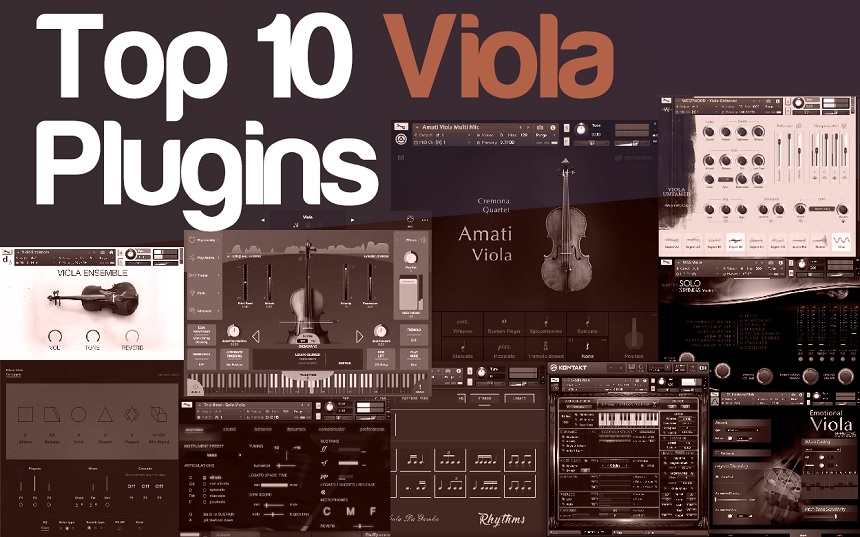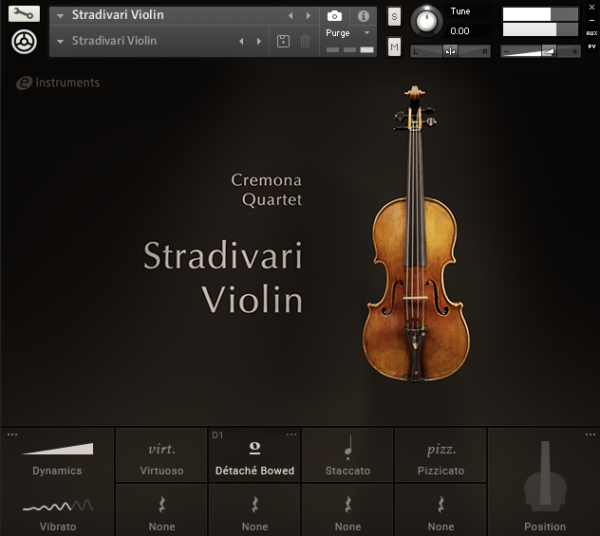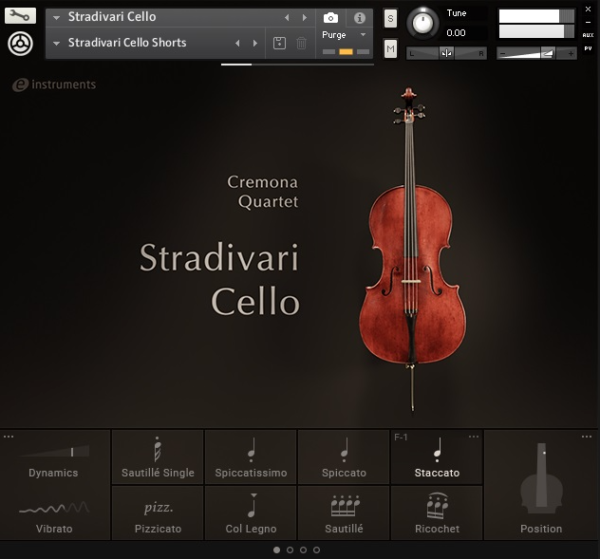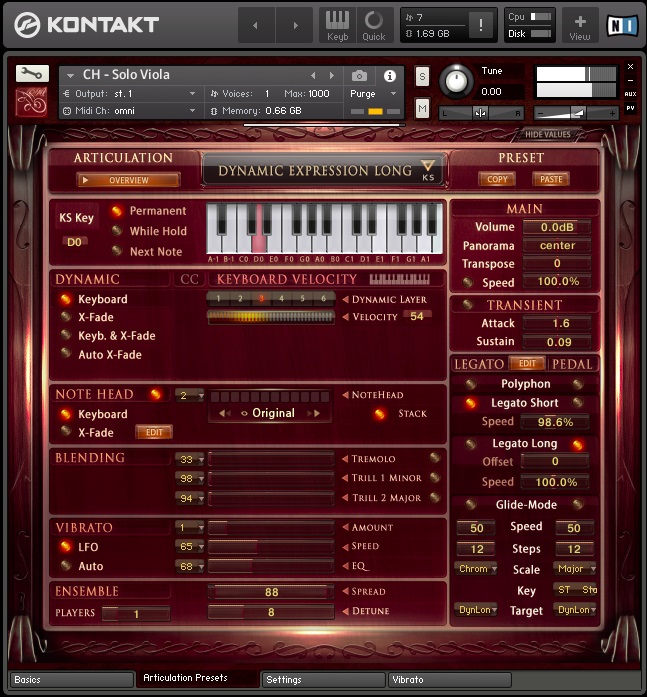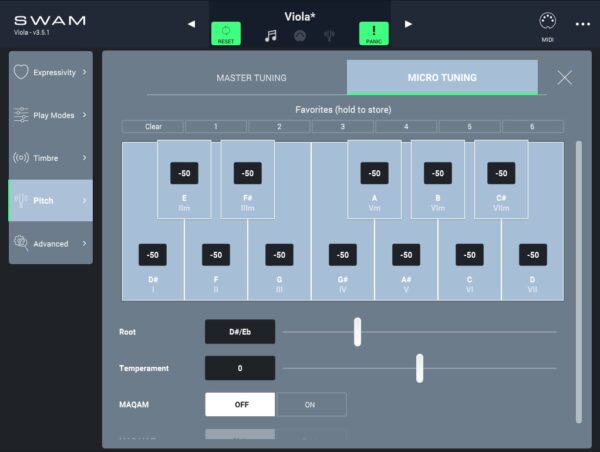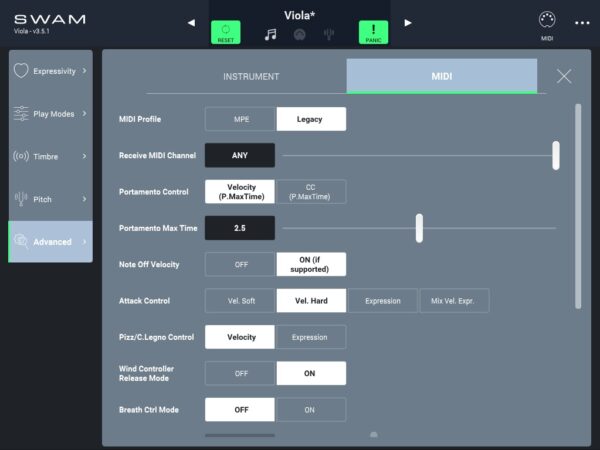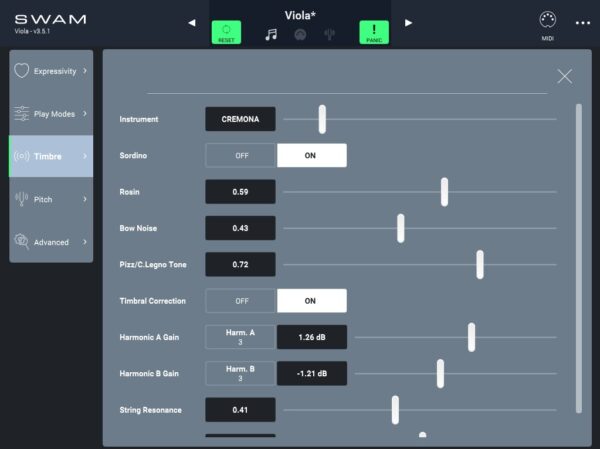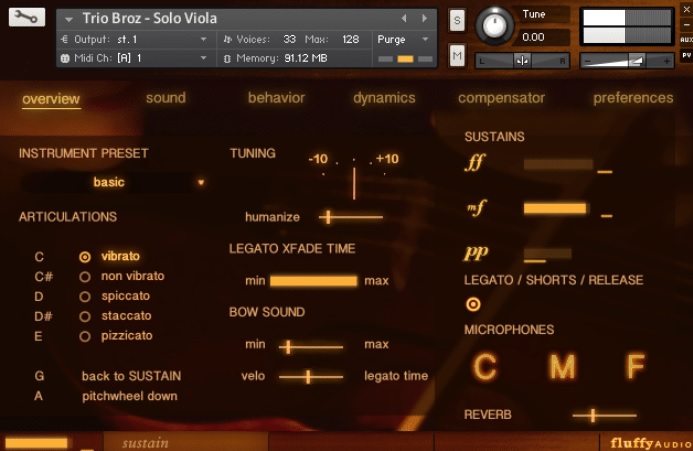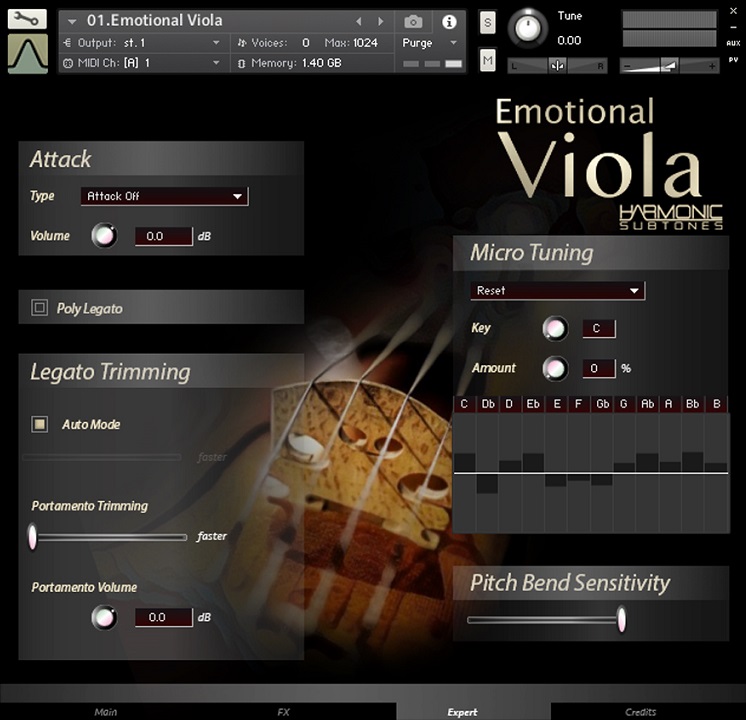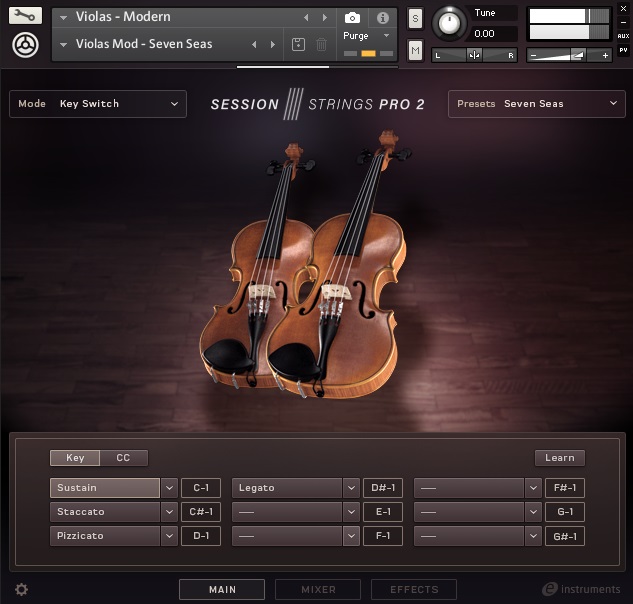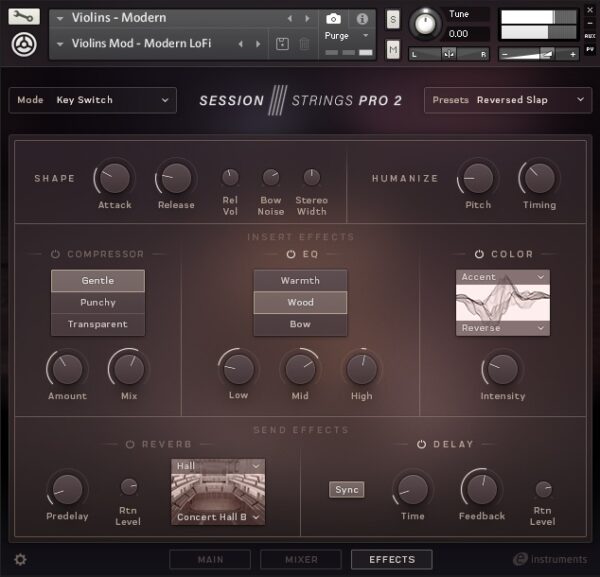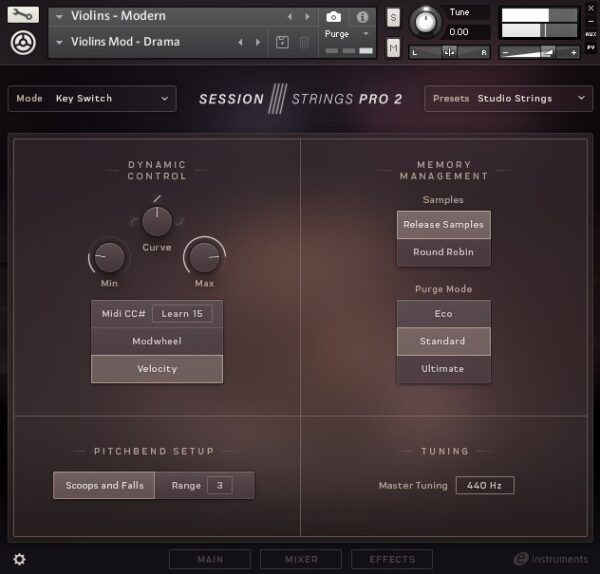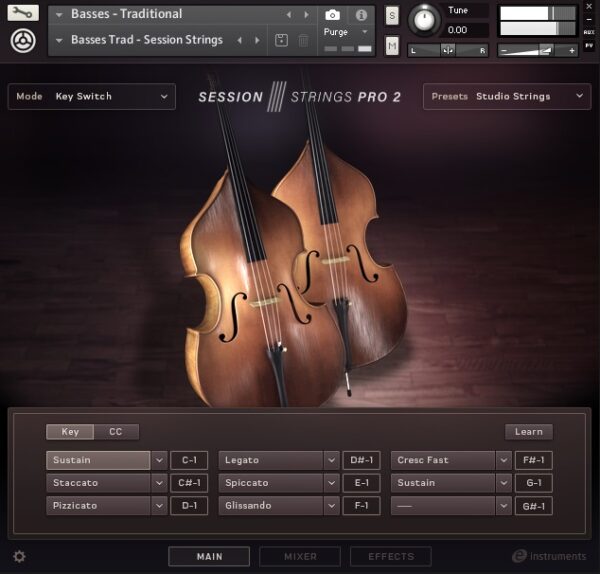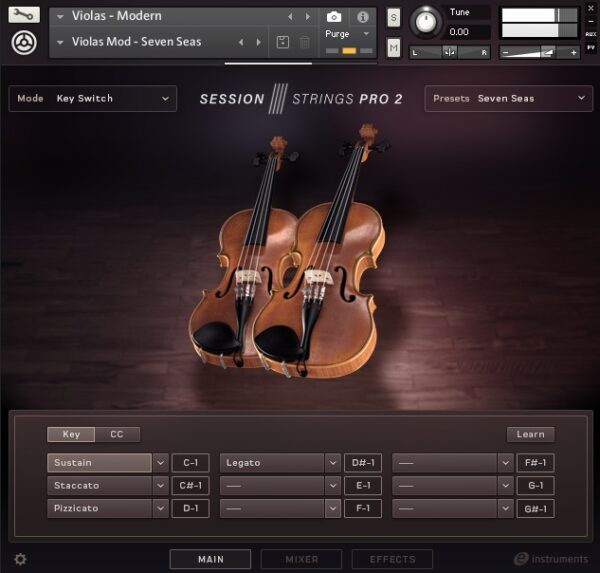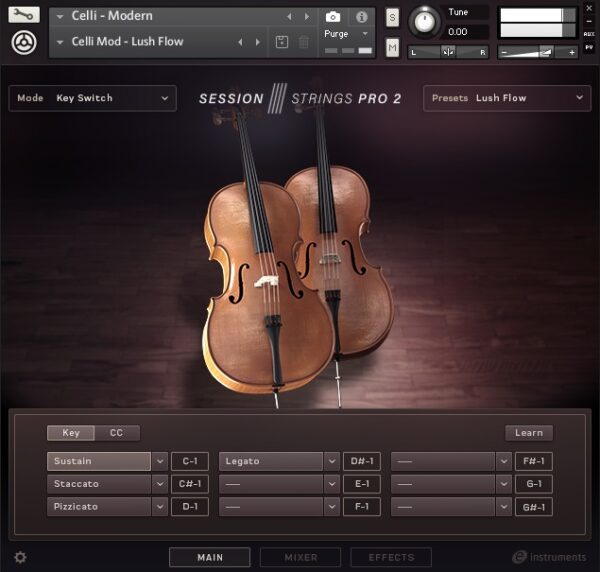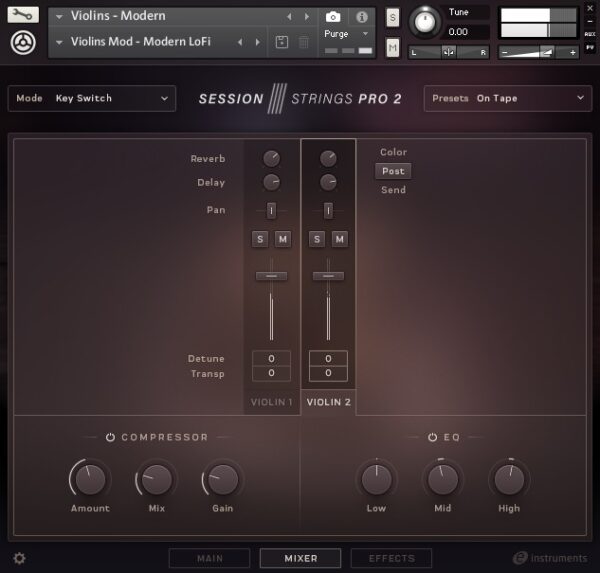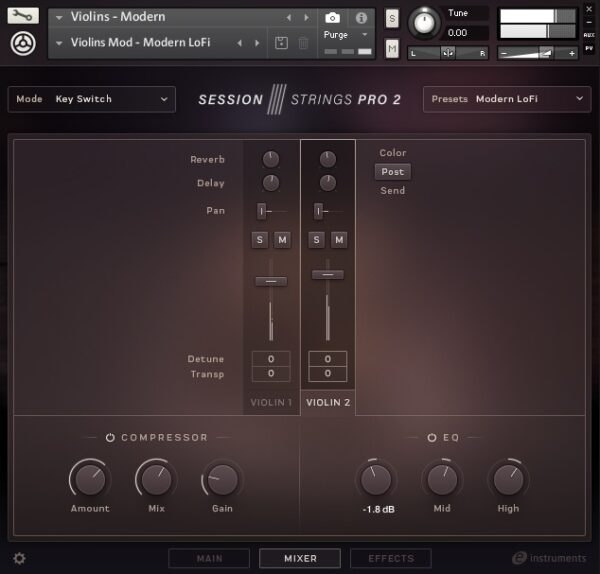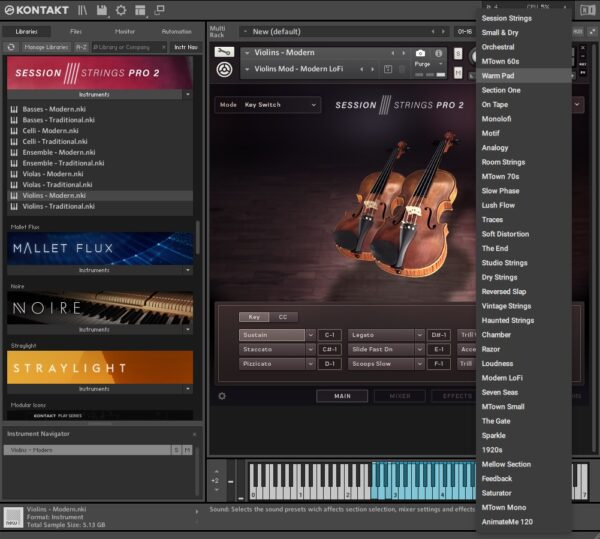Whether you’re looking to set up the ultimate string quartet for your compositions or part of that niche of connoisseurs who appreciate the viola, you’ll want to read this post to the end.
The violin and the cello are usually the protagonists of the bowed strings outshining the viola since the first one has a brighter sound and more presence and the latter more body and a wider range.
Nonetheless, the viola has a perfectly balanced sound that excels in warm and mellow tones, being able to play very sweet forte high notes without sounding too harsh (unlike the violin) or very light and delicate mid-range notes (unlike the cello).
So this instrument doesn’t get all the love and attention it deserves from most people, especially snobs elitists in the classical music world. But fortunately, many music software developers gave that love to the viola and captured its magic with their particular approach.
Without further ado, here is our selection of the best solo viola and ensemble plugins and Kontakt libraries.
Top 10 Viola Plugins & Kontakt Libraries 2024 With Most Realistic Sound
1. Native Instruments Amati Viola (Part of Cremona Quartet Kontakt Library)
The legacy of a legendary family of luthiers, an instrument of over 400 years.
The city of Cremona, Italy, has been the place of birth of some of the most important luthiers in the history of western music. Among these iconic instrument makers, we have Andrea Amati, who is often credited for the invention of the violin and viola we use today. In 1614, his son Gerolamo Amati built the Stauffer viola; the instrument used to make this library.
Native instruments partnered with e-instruments and tasked them with recording and sampling this piece of music history. Recorded in the Auditorium Giovanni Arvedi with 32 carefully selected microphones placed throughout the hall and performed by many maestros to capture every detail to make the most faithful digital recreation of the Stauffer viola.
Key Features:
- Faithfully Captured:
The ability of a virtual instrument to give an authentic performance depends on its articulation.
For this library, 20 articulations are provided categorized in LONG (sustain, marcato, and détaché), SHORT (sautillé single, spiccatissimo, spiccato, staccato, and pizzicato), EXPRESSIVE (tremolo, trill, ricochet, and sautillé), DYNAMIC (crescendo, diminuendo short, and diminuendo long), SPECIAL (sul ponticello, sul tasto, harmonic, and col legno), and, additionally, an ADAPTIVE category with a Virtuoso articulation that selects sustained, marcato or portamento depending on velocity while spiccatissimo or staccato depends on the pitch-bend wheel.
Each of these articulations comes with up to five legato transitions and eight assignable key switches.
- Placement & Ambience:
The recording of the 32 microphones is reflected in a simplified mixer with three channels (close, mid, and far) and the pan controls; instead of reverbs, the ambience is provided by the natural reverberations of the hall of the Auditorium Giovanni Arvedi.
Additionally, a second resource-saving NKI with a single channel called Stereo provides a fixed blend of the three channels.
- Position:
There are three selectable preferences for fingering position to choose the most suitable timbre for a determined passage. Use High String for a brighter and metallic timbre, Low String for softer and more delicate passages, or Smart to let the engine intelligently choose the most appropriate fingering.
There’s also a Force Open String function to play open string notes whenever possible.
- Vibrato:
The samples for this virtual instrument were recorded non-vibrato, so pitch variations and artificial undulations based on captured performance are applied to add expression and realism to the performance.
There are three controls to adjust vibrato: Rate, Vibrato (depth and intensity), and Style, which opens a dropdown menu with several presets (Passionate, Intensity, Wide, Evolving, and Narrow).
Compatibility:
The library is available for Kontakt Player 6. Kontakt is available for Windows 10 or higher and MacOS 10.14 or higher, both 64-bit only. It comes in VST 2/3, AU, and AAX formats.
Summary:
Amati Viola offers a faithful recreation of the Stauffer with its detailed articulations and well-implemented GUI, and understanding and mastering its functions takes little time, and the results are rewarding.
The only issue is that you can’t buy it individually since it forms part of the Cremona Quartet. With that in mind, these instruments are meant to be played as an ensemble since they were all recorded in the same place, so they mix seamlessly, giving the sensation of a live quartet instead of four instruments recorded individually.
So if you’re looking for a great string quartet, this might be the one; otherwise, if you’re looking for just a viola, there are other great options.
2. Chris Hein Solo Viola EXTended (Kontakt Library)
Image: Chris Hein
Flexibility beyond imagination thanks to the extensive care and diligence put into its development.
Three violas are featured in this Extended version: VLA1 Solo Viola, VLA2 Canadian Viola and VLA3 French Viola as EX-Instrument. This library provides an impressive number of 20,000 samples and 38 articulations, four legato transitions, and smooth phase alignment for inaudible crossfades.
The three violas included in Solo Viola EXtended were recorded by the internationally renowned virtuoso Naomi Binder, who played both violin and viola in classical concerts and crossover projects and has performed worldwide.
Key Features:
- Room & Body:
All the samples were recorded in mono and totally dry environments, so the ambience is provided by the Body and Room convolution reverbs. These two have their independent channel, with Body focusing on short responses and comes with 21 IR presets. On the other hand, Room gives proper definition to the simulated location and has 40 presets.
- Smooth Transitions:
The playable dynamics include up to eight layers to ensure natural transitions and four dynamic modes. In Keyboard mode, these layers are controlled with the MIDI keyboard; X-fade smoothly blends the transitions from layer to layer; Keyb. & X-fade mode combines the two modes previously mentioned, and Auto X-fade provides a fader for curving the dynamics to smooth the transitions.
- Performance & Sound-Shaping:
By clicking the toggle on/off, the con sordino articulation and round-robin functions can be activated. Furthermore, there are also volume envelopes, controls for dynamic curve and pitch bend and a micro tuner.
As for timbre and ambience, a DSP/FX section contains basic effects such as a parametric EQ, filter, compressor, flanger, phaser, delay, chorus, and reverb.
- Legato:
For wild fast passages, use the Short Legato mode. While in Long Legato mode, the portamento can be manipulated using the sustain pedal. Lastly, Glide-Mode inserts notes between two intervals played.
Compatibility:
The library is available for Kontakt Player 6. Kontakt is available for Windows 10 or higher and MacOS 10.14 or higher, both 64-bit only. It comes in VST 2/3, AU, and AAX formats.
Summary:
Solo Viola EXtended provides users with a plethora of options for purpose versatility. Some samples feature a little bit of noise, which can be upsetting, but overall the sound is smooth and lush.
Consider this option if you need a Swiss Army knife library that can withstand fast virtuoso playing.
3. Audio Modeling SWAM Viola (Plugin)
This plugin offers unique possibilities that differentiate it from the rest by using physical modelling instead of samples.
The technology behind this modelling is based on Digital Waveguide Synthesis by Professor Julius O Smith, thus providing control in real-time of bow speed, bow pressure, vibrato, and other elements; thanks to that, the sound is full and rich. Furthermore, the mapping settings grant users much freedom, enhancing realism and expression.
This upgraded version comes with a warmer sound and upgraded modelled instruments, now boasting more clarity in the details. Also, new features were integrated and are elegantly presented in the form of menus, giving the option to adjust Expressivity, Timbre, Pitch, and more.
Key Features:
- Performance Customisation:
All the functions in this plugin are customisable, so you can map them however you want to adjust them to your play style. Because of this, the amount of control over each aspect of the instrument is above most of the competence.
Even the tiniest details like bow pressure or rosin are adjustable and can be mapped to any key or slider on your MIDI keyboard, improving the performance’s expressiveness and realism.
- Scordatura:
One feature that sets this plugin apart from the rest is that it allows changing the tuning of the strings, i.e. scordatura, which can be done by accessing the Advance menu; there, you can change the tuning of the lowest (C) string or choose between intervals of 4th or 5th for the tuning of the rest of the strings.
- Tone Shaping:
In the Timbre menu, we can shape the tonality of the instruments with the many options provided. Cremona, Firenze, Venezia, and Electric are the three models that determine the main characteristics of the instrument’s tone.
There’s also the con sordino toggle on/off, rosin and bow noise horizontal faders, and other controls like timbral correction, string resonance, and more.
- Articulations in Physical Modeling:
These modelling techniques make the performance natural and intuitive for the user. Instead of the common limitation of having the same sample being played in a range of velocity or having to press a key switch to change the articulation, you get a different sound depending on how hard you press the key or play staccato depending on how long you press it, for example, or even play legato (which in bowed strings means to change the note you’re playing without changing the direction of the stroke of your bow).
Furthermore, you can play harmonics and control the vibrato with the pitch bend, which is impossible with samples.
Compatibility:
This plugin comes in VST 2/3, AU, NKS (for Kontakt 6), and AAX formats and is available for Windows 10 or higher and MacOS X 10.10 or higher.
Summary:
The physical modelling in this plugin offers more flexibility in terms of expression and performance compared to pre-recorded sample-based virtual instruments. Also, thanks to the adjustable MIDI mapping, users can program the plugin to fit their style for live performance.
In that regard, this plugin might be the best option regarding playability. However, remember that physically modelled instruments are usually more CPU-hungry than sample-based ones.
4. Felt instruments BLISKO Viola (Plugin)
More Info & Price
This plugin offers unique shimmering textures by stepping out of the convention.
As time goes on, string libraries get cleaner and more ambitious and epic, but the Blisko Strings Bundle – which includes Blisko Viola – takes the opposite direction, as it focuses not more on long notes, slow passages, and non-traditional playing techniques for the creation of emotional, intimate, and very human and imperfect textures.
Tomek Ślesick (founder of Felt Instruments) discards the usual legato, spiccato, staccato, and the rest of the more traditional articulations to provide composers with new sounds that, otherwise, are impossible to get without having a group of musicians in the studio.
As a result, the sound of the Blisko Viola ranges from intimate and delicate to immense and haunting and has an airy quality that makes it feel as if being played in your presence.
Key Features:
- Microphones:
A collection of hand-made microphones was used for the recording while connected to vintage Telefunken and Neumann pre-amps. During this process, no noise reduction or further processing was applied, which gives it a very analogue and natural character.
These mics are represented in two channels: close and far, and each channel has an A and B option to choose the pre-amp, although it’s not specified which one is which.
- Unconventional Articulations:
Felt Instruments stepped out of the competition for the best virtual viola and instead created a plugin that has its niche. The articulations are separated into two groups: Shapes and Moments. The first one consists of single articulations and includes Ark, Rise, Col Legno, and Ricochet.
As for the latter, you can select up to 3 articulations and transition seamlessly from one to another using the mod wheel, which includes Sul Tasto Pulse, Col Legno Sustains, Flageolet Trills, Flageolet Tremolo, Pointillist Sustains, Tremolo Bursts, and Custom.
- Minimalistic:
All the controls are elegantly presented in the main section of the GUI, which is divided into three parts. On the top, we have the Attack and Release envelopes, levels of Echo and Reverb, the number of Players (up to three) and the close/room Mic Blend.
In the middle sub-section, there are individual channels for Players 1, 2, and 3 with gain faders and pan knobs, the Close and Far (room) channel faders for more precise controls and an Output gain fader as well, and the Cascade function, which rhythmically offsets the instruments’ entry and is very useful for creating interesting textures; it also works very well when combined with the Variance function in the sub-section below, of which we’ll dedicate a section of its own.
- Natural Seamless Sound-Shaping:
At the bottom of the GUI, we can find the effects and some other functions. This section includes an EQ, Echo, Reverb, Variance, Divisi, and MPE. The effects are very and blend seamlessly, especially the echo delay, which has three types.
Furthermore, the reverb feels very natural and works incredibly well with the far mic; it also gives a sensation of a bigger ensemble, increasing the textural possibilities and compensating for the small number of players.
Compatibility:
This plugin comes in VST 2/3, AU, and AAX formats and is available for Windows 10 or higher and Mac OS X 10.11 or higher.
Summary:
Since it’s so unconventional, this virtual instrument works great for a composer mindset by offering textures and articulations most other plugins or libraries don’t.
It works great for composing for film or games, but it’s not the most suitable for, let’s say, more traditional or melodic playing considering it doesn’t even have a normal legato articulation but with an added effect like sul tasto. Blisko Viola is destined to satisfy very specific needs, and it does so excellently.
5. Westwood Instruments Viola Untamed (Kontakt Library)
Another library goes out of the norm, delivering intense and dramatic sensations.
Part of the Untamed series, this viola is not meant to be your usual legato instrument for traditional playing; instead, it combines traditional and unusual articulations to create sensations, whether using long sustained notes and increasing the number of players or short notes for rhythm and movement.
This viola was recorded with the utmost care for the details and quality of the samples by using a set of vintage microphones from brands like Brauner, Neumann, and Oktava through Neve and API pre-amps, aiming for the perfect sound for strings.
Key Features:
- Layout:
All the features appear on a single – elegant black and white – display for commodity, so there is no need to access new menus. It’s all in plain sight. On the top left, we see envelope controls for the articulations, only an Attack knob for the Longs and, for the Shorts, Attack, Tightness, and Release.
Next, on the top right, are the Performance and Microphone Mixer sections; on the Performance, we find sliders for Dynamics, Expression, and – a much-needed – Vibrato, and on the Mixer, we have four channels for Close, Mid, Far, and Gallery mics.
The effects are located in the middle; there, we find a three-band EQ, tape Saturation with Warmth and Gain knobs, and Space, which comes with Width and Reverb knobs and six IRs.
On the bottom, the articulations are located; there, we find the Improvisation, Storm, Glue, Glue 8vb, Normale, Flautando, Sul Pont, Tremolo, Circular, False Harm[onic], Spiccato, and Pizzicato.
- Improvisations:
The sustain samples are grouped in seven sets called Improvisations; these are A1, A2, B1, B2, C1, C2, and R.R. (round robin). A2, B2, and C2 use the same samples as their counterparts but start at a different point, taking advantage of the fact that the samples for the long articulations are about 25 seconds of recording.
- Glue:
Every virtual instrument in the Untamed Series includes the old trick of adding sine waves. The reasoning behind this is quite simple; sine waves are excellent for seamlessly thickening up the natural sound of the strings – this trick works great for many instruments, especially woodwinds.
Westwood sampled pitches of a sine wave across the entire range of the viola recorded through a reel-to-reel tape to give it some sharpness and thus make it feel more natural. Two versions of this are included, one of the same pitch of the note played and the other one octave below (8vb).
- Excellent Recordings:
From the get-go, the sound is production-ready and well-implemented in the articulations, resulting in a very passionate and human character. Thanks to the thickening of the sine wave, the sound is fat. However, it also has an intense brightness that makes it very present.
Going specific in describing the sound in the articulations, the Flautando, False Har[monic], and Sul Pont are very airy and subtle like a murmur, but the first two are more delicate while the latter has a more unstable and unsettling quality; the Spiccato and Tremolo are very bouncy, precise and assertive and, along with the Pizzicato, have a lot of body (as you would expect from a viola).
Furthermore, the Normale and Improvisations have, too, a lot of body but are also sparkly in an intense manner, which makes them very imposing; the Circular Bowing is quite the opposite from the Spiccato; although bouncy too, it is more imprecise and inconsistent, which makes it feel fragile.
And finally, the Storm articulation feels exactly as its name indicates; instead of swarming strings, it feels more like a thunderstorm coming from the distance and getting closer as the dynamics slider goes up.
Compatibility:
The library is available for Kontakt Player 5.6.8. Kontakt is available for Windows 10 or higher and MacOS 10.14 or higher, both 64-bit only. It comes in VST 2/3, AU, and AAX formats.
Summary:
The quality of the samples in the sets of improvisations is unquestionable; the sound is very thick and intense, although it also has a brightness that makes it feel a little overprocessed for a more classical viola section.
On the other hand, considering this library makes full use of sustains instead of legatos and the sound qualities make it feel so dramatic, this library works best for film or games and similar.
One downside I find is that the transitions from note to note with the sustains feel a little disconnected, giving a notion of different samples being triggered in note successions instead of several instruments playing, which seems odd considering the sample transitions when manipulating the dynamics are smooth and seamless, probably the best ones I’ve heard.
Ultimately, this library finds its niche in incidental music and does a superb job.
6. Auddict MASTER Solo Strings – Viola (Kontakt Library)
Carefully captured to create the most detailed virtual viola.
Auddict’s initial intention was to begin the Master Solo Strings collection with the violin, which usually is a no-brainer considering it is the most popular bowed string instrument in the world. But because of that, and since there were (and still are) way too many solo violin libraries, they decided to launch this series with the viola instead.
The London-based company put a lot of work into faithfully recreating this instrument with an immense number of samples, 14 articulations, and ambience control. And all that work paid off. The sound is faithful, well-balanced, and rich in details, and the tools it comes with offer control over the performance with ease, thanks to the simple GUI.
Key Features:
- Microphones:
Part of what makes this instrument sound so rich in detail is its six microphone channels, of which three are spot mics.
Of course, many other companies use a crazy number of mics to record their libraries too, but allowing the users to have more agency over shaping the sound with these channels makes a big difference in how detailed the sound can get.
These channels are Spot LDC, Spot SDC, Spot Ribbon, Close Pair, Stage POS, and Room POS.
- Over 23,000 Samples:
Making a good virtual instrument involves scripting and the tools that help it sound authentic. But all of that is useless if the instrument or ensemble is not captured appropriately. In the end, the samples are the core of a good VI, which is why Auddict worked extensively to record up to the tiniest detail of the viola, resulting in over 23,000 samples.
- Legato:
There are four true legato articulations included in this library, along with two polyphonic legato – Legato Vib, Legato No Vib, Portamento Vib, Portamento No Vib, Polyphonic Vib, and Polyphonic No Vib.
These articulations are beautifully played, especially in the high register, and the transitions are incredibly smooth. Sadly, as for the polyphonic legato, it is apparent that two legatos are being played instead of two strings being stroked simultaneously.
- Chords:
This library offers something I haven’t seen anywhere else: the ability to play chords, which is understandable since broken chords are not the most frequent element in the bowed strings repertoire, but it’s nice that someone remembered they exist and captured them superbly, offering major and minor broken chords.
Compatibility:
The library is available for Kontakt Player 4 or higher. Kontakt is available for Windows XP or higher and MacOS 10.5 or higher. It comes in VST 2/3, AU, and AAX formats.
Summary:
Very straightforward and simplistic, this virtual viola focuses on sound and performance and disregards effects like a compressor or an EQ, only having a single knob reverb, although the six microphone channels do a better job at creating the ambience more naturally.
It’s also worth mentioning that, as of the time of writing this post, this library is on discount (50% off), so go check it out, listen to the demos and see if this is the one that adapts better to your needs and playstyle.
7. Fluffy Audio Trio Broz: Solo Viola (Kontakt Library)
More Info & Price (Trial Available)
Ideal for creating emotional phrases and dramatic lines full of energy in a high register.
This library was recorded by Giada Broz from the Trio Broz – three siblings that have performed together for over two decades – in the Teatro delle Voci. It features a special device developed by Fluffy Audio for keeping consistency between samples.
This instrument features 3.5 octaves of range, three – close, mid, and far –microphone channels, and a reverb effect with seventeen impulses.
The articulations include legato vibrato and non-vibrato with three dynamic layers for sustained articulations and short articulations like staccato, spiccato, and pizzicato, which include four round robins. Also, a humanise option increases the range of pitch inconsistencies for a more authentic sound.
Key Features:
- Dynamic Control Engine:
Worried about over-processing the samples with compression and normalisation, Fluffy Audio developed a scripting device to blend the sample transitions smooth and naturally.
These tools work by analysing the samples and sending the data to Kontakt, so it knows the volume of the sample currently playing and matches the volume of the incoming samples with the previous ones.
- Behavior:
This section changes according to whether the articulation is Legato or Short.
For the Legato, we can find controls for the duration of the samples and how the crossfades are implemented as well as a Synth Vibrato which, being honest, leaves some to be desired; stick to the legato vibrato. For the Short articulations, controls for the shape, cycle, and selection of the round robins.
- Legato Vibrato:
One of the best features in this library is the legato vibrato articulations – accented attack, crescendo attack, decrescendo release, fingered Legato and vibrato – as the transitions are superbly implemented, resulting smooth and very natural, which sadly isn’t the case for the non-vibrato, as the crossfade samples have vibrato.
- Pitch-Bend Wheel:
The dynamic articulations, like accented notes and crescendo attacks, as well as the legato articulations, can be manipulated using the pitch-bend on the MIDI controller; this way, you can write beautiful phrases with faded ends or abrupt accented notes.
Compatibility:
The library is available for Kontakt Player 5 or higher. Kontakt is available for Windows 7 or higher and MacOS 10.10 or higher, both 64-bit only. It comes in VST 2/3, AU, and AAX formats.
Summary:
This library includes uniquely implemented features that evoke a more natural sound, performance, and vibrato articulations. The DCE helps keep everything consistent between sample transitions without sounding over-processed.
Some of the impulses don’t offer a very realistic sound, and the synth vibrato feels too… well… synthetic; but fortunately, these are not essential elements.
8. Harmonic Subtones Emotional Viola (Kontakt Library)
More Info & Price (Trial Available)
This library offers a plethora of performance possibilities from conventional to niche territory.
The final instalment of the Emotional series and recorded under the same conditions as its predecessors. This instrument is easy to play and configure and offers numerous possibilities with its impressive number of articulations.
The sound is very lush and has a lot of body. It also has a brightness usual for this series that helps it cut through the mix, so it doesn’t require too much tweaking. Besides that, the ambience options are great, having both room and reverb configurations.
Key Features:
- Sampling:
Several string instruments were sampled in many different ways for over four years resulting in over 100 articulations and their variations to capture the aspects of a player’s performance like their natural vibrato or the true legato. These articulations were then liked through very elaborate, intelligent scripting.
- Authentic Performance:
Intending to evoke the feel of human performance, Emotional Viola provides a hefty number of articulations that go from the traditional spiccato or pizzicato to unusual niche territory like Nordic Variety.
There are 25 individual articulations displayed on the left of the GUI and 18 ornaments on the right. The ornaments are programmed with a Momentary Key Switch system that allows activating the ornaments mid-note. Also, the articulations can be purged to reduce the CPU load.
- Control The Smallest Details:
The tools we find in the Expert tab are quite exceptional as they provide agency over sample behaviour. There’s nothing new with the Attack control, as most virtual instruments have one, although it’s unusual that you choose the shape of attack from a dropdown menu instead of controlling the attack time with a knob or slider as usual.
The Legato Trimming comes with a slider that controls how quickly the trimming occurs, and the same goes for the Portamento, which also has a volume knob. Finally, there’s a Micro Tuning control for scordatura or to offset the tuning for realism as there’s no such thing as a perfect pitch in real life. Additionally, there’s also a Pitch Sensitivity slider.
- Character:
The FX tab provides five tools to work with: Sordino, Timbre, Equilizer, Room, and Reverb. The Sordino is self-explanatory; a check box that toggles on/off the con sordino feature. Timbre is for selecting the tonal instrument’s tonal quality by accessing a dropdown menu with fifteen options.
The EQ has three bands and is semi-parametric. Lastly, Room and Reverb set the ambience, with Room working as a convolution with nine IRs and Reverb containing five hall algorithms.
Compatibility:
The library is available for Kontakt Player 5 or higher. Kontakt is available for Windows 7 or higher and MacOS 10.10 or higher, both 64-bit only. It comes in VST 2/3, AU, and AAX formats.
Summary:
The quality of the samples is great, although some of the articulations have a harsh airiness that might feel unpleasant but can be easily solved with EQ. The strengths of this library are the vast number of articulations that provide versatility and the MKSs, which are great for smooth transitions.
9. Decent Samples Viola Ensemble (Kontakt Library)
Design for incidental music such as film and games.
We have the pandemic to thank for the making of this library. Its creator, violinist Dave Hilowitz started studying viola in 2020 and decided to sample some recordings for film work and eventually decided to make it available for everyone else.
This ensemble is very simple, there’s only one articulation, and dynamics are controlled with the mod wheel, also increasing the number of instruments in four levels: two when down all the way, four and six in between, and eight up all the way. Additionally, there are Tone and Reverb controls.
Key Features:
- Excellent Price:
A lot of work, expensive equipment and people are required whenever a music software developer decides to make a virtual instrument which is why usually these things aren’t cheap. On the other hand, we can always find cheap or free instrument libraries, but usually, they’re not good or simply underwhelming.
So it is a rare occasion whenever we stumble upon an instrument library that is both affordable and great sounding such as this one.
- Easy User Experience:
Most good instrument libraries come with an impressive number of articulations, effects, key switches, mapping options, etc. And as time goes on, we see how the quality of these virtual instruments and ensembles and the user experience keep improving as developers figure out how to make them easier to manipulate.
However, when you’re just beginning, as easy as they might be, it’s still overwhelming since we don’t know how they work or how to make them sound how we want. Fortunately, Ensemble Viola offers a ready-to-go sound with easy controls that work as our first steps into this crazy world of musical instruments inside computers.
- Good Quality Recordings:
Although it’s very basic and limited in the number of samples, the sound is very good and has a somewhat lighter and delicate sound while maintaining the warmth the viola is known for.
There’s something about this kind of project of one person recording and sampling an instrument in their room that makes the authenticity permeate through the plugin, probably because there’s less treatment and noise reduction.
Compatibility:
The library is available for Kontakt Player 5.8. Kontakt is available for Windows 10 or higher and MacOS 10.14 or higher, both 64-bit only. It comes in VST 2/3, AU, and AAX formats. Also Available for Decent Sampler and SFZ.
Summary:
David did an amazing job with this library, as it offers quality at a low price. In addition, its light and delicate sound work great for what it’s intended and range from intimate, gentle murmurs to a full raging viola section. In other words, you just can’t go wrong with this one.
10. Ben Osterhouse Viola Da Gamba (Kontakt Library)
More Info & Price (Trial Available)
A long-forgotten instrument from the Baroque era that comes back to life with a new interesting approach.
Ben Osterhouse is a cellist, composer, sound designer, and virtual instrument designer. After experimenting with the viola da gamba and becoming captivated by its unique sound qualities, he made this library all by himself, which is not an easy task.
This library comes with two NKIs, one for articulations and the other for rhythmic patterns like ostinatos. There are 12 articulations, some of which are the more traditional bread-and-butter ones we find in every plugin or library, while others are sounds unique to the instrument.
It’s also worth mentioning that you can layer these articulations for experimentation, like creating new, never-before-heard textures.
Key Features:
- Interesting Non-Conventional Sounds:
The Short articulation is some type of shorter portato note, which is very uncommon, as it is very brief but not enough to be staccato, and its character is very soft. Scratch is sul ponticello and receives that name because the sul pont sound on the viola da gamba is completely different from modern instruments and has a gritty sound.
Rough is another excellent drone articulation, somewhat similar to a hurdy-gurdy, and has this particularly cool gritty sound; also, some of the notes are slightly out of tune, giving it an interesting vibe.
- Conventional Long Articulations:
The Long Bow fulfils the role of the main sustain articulation and contains two dynamic layers controlled by the mod wheel. The Endless Bow is pretty much the Long Bow, but with the bow changes edited out and works great as a drone. The Tremolo is pretty much what you would expect; however, it has a dynamic layer to transition to sul ponticello.
The Trills work by holding two keys; the direction of the trill is determined by which key was pressed first, ascending if the lower key was pressed first and descending if the opposite; this same mechanic works for the Turns as well. Finally, the Swell has a lot of character and is perfect for modern appliances with its abrupt ends.
- Short Articulations:
For the Staccato, Ricochet, and Pizzicato, Osterhouse went “gung-ho” with the round robins to prevent them from sounding like a machine, especially the Ricochet, which has 12 round robins.
Also, the Pizzicato has samples of plucking the strings with the finger and with a guitar pick, of which the latter is triggered when pressing the keys at high velocities and dynamic layers for plucking more centred or closer to the bridge.
- Rhythms:
In this NKI, we find 11 rhythms with combinations of notes of different lengths that, just like the articulations, can be layered to create very interesting polyrhythms. Also, the Pattern Mode allows users to select several rhythms and play them in succession.
Compatibility:
The library is available for Kontakt Player 5.8.1 Kontakt is available for Windows 10 or higher and MacOS 10.14 or higher, both 64-bit only
Summary:
The work done with this instrument is excellent. It boasts a very lush and beautifully captured sound, and some of its articulations, like the Tremolo or the Scratch, have an unstable consistency in the playstyle that makes it feel like being played by a person.
And if that wasn’t enough, one more perk it offers is that the price is very affordable, so it is worth trying when considering the relation between the investment and the reward.
Bonuses:
1. Native Instruments Session Strings 2 Pro (Kontakt Library – Violins, Violas, Cello & Double Bass)
If you’re looking for the feel of an incredible modern string ensemble, this library might be the one for you.
The first Session Strings Pro had a reputation of being unimpressive, especially compared to many other amazing plugins and libraries out there. But Native Instruments upped the ante with SSP2 with many new tools to improve the expression and user experience.
To give a performance that feels authentic, this library comes with 22 different articulation samples and 9 customizable key switches giving the user control over the performance. You can also choose between traditional (left to right from highest to lowest) and modern (celli and basses in the center and violas and violins to the sides), depending on your needs.
Key Features:
- Mode:
With Velocity Switch mode, you have a default articulation and one that triggers once the MIDI velocity surpasses a threshold.
For better control, assign the articulations you need to the keys you want with Key Switch mode, which is simple and effective. Rhythm Animator mode works like an arpeggiator; it has a grid of up to 32 steps to set the pattern and six articulations to choose from for each step. Phrase Animator works like an arpeggiator too, but focuses on preset melodies and passages.
- Presets:
There are 48 different presets to help users adjust the vibe depending on their needs. You can select from a plethora of different settings to sound like a full orchestral string section, a more modest chamber orchestra ensemble, strings that feel recorded in a studio, or even give it a more LoFi feel.
These presets are also very useful to get an idea of how all the tools can be used to get the sound desired or as a starting point and then make minor adjustments to give the feel you want.
- FX Section:
This menu displays an incredible yet simple rack of effects divided into three sections. The first one is the envelope controls called Shape and Humanize to control aspects of the performance such as Attack, Bow noise, Pitch, Timing, and more.
The second one is the insert effects that feature a Compressor, a three-band EQ, and Color; the compressor can be adjusted to have gentle, punchy, and transparent compression, and the color control acts like a pre-amp to enrich the sound and can select different units and has an intensity knob; the EQ also has three modes (Warmth, Wood, and Bowed) to enhance specific frequency ranges.
And the third one is the send effects section, which has reverb and delay; reverb comes with pre-delay and return level knobs and different types of reverb, while delay has time, feedback, and return level knobs; both send levels can be controlled in the mixer.
- Mixer:
This section comes with the traditional faders and pan knobs for each channel, but also we find send level knobs for reverb and delay, solo and mute buttons, detune and transpose controls, and additional compressor and three-band EQ besides the ones in the FX section for better tone shaping.
Compatibility:
The library is available for Kontakt Player 5 or higher. Kontakt is available for Windows 10 or higher and macOS 10.14 or higher, both 64-bit only. It comes in VST 2/3, AU, and AAX formats.
Summary:
If you’re looking to compose for a viola section or a string ensemble, Session Strings Pro 2 is a force to be reckoned with, but keep in mind that this library was designed to be used as sections, so it doesn’t offer solo instruments. Also, this library is rather expensive.
Arturia Augmented Strings (Versatile Plugin)
More Info & Price (Trial Available)
A new and fresh approach. A classic string ensemble fuses with synthesisers and effects to create new cinematic soundscapes of never-before-heard textures.
Arturia has made a name for themselves for recreating vintage synths and then boosting them with new tools, but they’ve also ventured into acoustic and amplified instruments with the keyboards and Pianos in their V Collection, recreating several famous pianos and iconic electric pianos like the iconic Fender Rhodes Stage 73 or the Wurlitzer.
The idea for this plugin is very simple: combine a string orchestra with several synth engines and effects to “augment” them into something completely new. The functionality of this plugin is pretty much preset-based, as it offers a bunch of presets of string samples combined with wavetable, analogue, harmonic, and granular synthesis.
Key Features:
- Macros:
Augmented Strings house eight macro controls: Morph, Time, Color, Motion, FX A, FX B, Delay, and Reverb. Morph is the motor that puts the machine in motion, which allows the user to move between layers of string samples and synth sounds (A and B) or multiple parameters simultaneously, promoting experimentation and stimulating creativity.
- Big Collection of Sounds:
Despite being preset-dependent, Augmented Strings offers a lot of flexibility with over 250 presets designed by the minds responsible for Pigments and the V Collection. Be it an authentic and traditional string ensemble, rich in harmonics pads with destructive sub-bass, or abstract in-your-face soundscapes.
- Modulation:
Although simple on the surface, this plugin provides you with the tools necessary for advanced sound design – as we would expect from Arturia. The modulation section is super simple, allowing users to click and drag settings. The generators in this section include multiple LFOs, Functions, Random Generators, and keyboard controls.
Compatibility:
This plugin comes in VST 2/3, AU, and AAX formats and is available for Windows 8.1 (64 bits) or higher and Mac OS X 10.13 or higher.
Summary:
This plugin is so effective because it’s very simple and straightforward. It’s a great tool for endeavours such as film or videogame scoring, being able to go from strings with a subtle dose of synths to full-cinematic or just eccentric. It’s also worth mentioning that the price is fairly affordable, considering all the perks it offers. There’s also a free demo version available, so it’s worth the try.
Conclusion
So there you have it, folks. Ranking the instruments for this top wasn’t easy considering that, more than an ultimately best library overall, each of these virtual instruments offers something unique in which they specialise, whether it is sound quality, playability, articulations, textures and experimentation, and so on. So, in the end, it’s more a matter of finding the one that best suits the needs of each individual.

Integraudio is an audio blog made specifically for musicians and those seeking audio knowledge.

